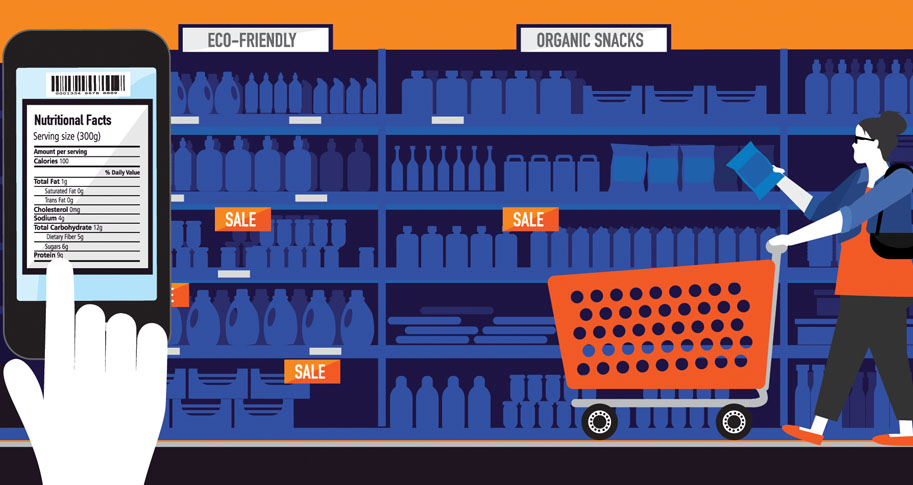
Take a look at some of the food products you bought on your last trip to the grocery store, and you’ll likely notice various health-related claims, such as “all-natural” or “no artificial ingredients” on many of them. These front-of-package (FOP) claims allow brands to communicate information to the consumers at the point of purchase. These include FOP processing claims regarding how the product was made (e.g., GMO-free, no artificial ingredients) and nutrient content claims (e.g., low sodium, low fat).
With 42% of Americans aged 20 or older being obese and obesity and unhealthy diets leading to an increased risk of life-threatening diseases, how consumers evaluate these package claims is a major issue for marketers and the public health community. As the authors note, “Consumers often rely on FOP claims for health-related information, and this information can affect their evaluations and choices.”
Prior research has focused on consumer evaluations of either processing or nutrient content claims in isolation. But in their article “Promoted claims on food product packaging: Comparing direct and indirect effects of processing and nutrient content claims,” Garrett Rybak, Scot Burton, Alicia M. Johnson and Christopher Berry extend this research by directly comparing evaluations of both nutrient content and processing claims, as well as “clean label” ingredients, on consumer perceptions of healthfulness and purchase intentions.
The Importance of Processing and Nutrient Content Claims
Processing claims are increasingly common on food packaging as a result of increased consumer demand for minimally processed foods. These trends have been shown to influence consumer purchasing behavior and have recently been dubbed the “clean label” movement, defined by the authors as consumers’ desire for food products that are “minimally processed, contain simple ingredients and are free from artificial and synthetic chemicals.” These processing claims influence consumer perceptions of how “clean” products are based on their evaluation of the level of processing and types of ingredients used.
Because nutrients like saturated fat, sodium, and sugar are associated with various ailments such as cancer and heart disease, nutrient content claims are heavily regulated, and the FDA’s definition of “healthy” foods is based upon these macronutrients. A recent survey suggested that 40% of consumers said their definition of healthy included processing claims such as “natural” or “organic.” Conversely, the FDA does not regulate many processing claims, and its current definition of “healthy” fails to consider how foods are processed. Therefore, it’s often unclear what these processing claims objectively mean, or how consumers understand these claims when making health-conscious, “clean label” decisions.
The Effect of “Nutritional Halos” on How We Evaluate Processing Claims
The authors’ study draws upon activation theory which contends that when a concept is primed in your brain, connections to all other related concepts spread. Past research has demonstrated the influence of activation theory on consumers’ health evaluations of products from FOP claims. Nutrient content information can lead to increased consumption, attitudes, and purchase intent. Processing claims have also been shown to increase customers’ health perceptions and willingness to pay even though many of these claims are not regulated and may be ambiguous.
“When certain products are primed,” the authors write, “they can spread to related but distinct constructs and create ‘halo’ effects.” These halo effects occur when customers ascribe favorable attributes to a product that do not directly correspond to the claims presented.
The authors find evidence of a “nutritional halo” that extends from package processing claims and influences consumer evaluations. In their experiment, a sample of adults, who were the primary grocery shoppers for their home, were asked to review product packaging and provide clean label and nutritional evaluations, as well their perceived healthfulness of the product and their likelihood of purchasing it. The authors found that the presence of processing claims (compared to their absence) positively influenced all four of these measures. The “nutrition halo” was present because processing claims significantly affected nutrition evaluation. This result is in spite of the fact that “objectively processing claims are not directly related to the nutritional content of the product; thus, they alone should not directly and significantly influence overall nutritional evaluations.” In contrast, the nutrient content claims positively influenced nutritional evaluations, perceived healthfulness and likelihood of purchase but did not increase clean label, product processing evaluations. This is because consumers do not see nutritional information as related to a product being “clean” or related to its processing level, the authors explain.
The Importance of Consistent Information on Packaging
Because many processing claims are not regulated, customers have fewer ways to verify these claims, “making them largely credence attributes for the typical consumer.” Conversely, both nutrient content claims and ingredient lists on the back or side of packaging are heavily regulated by the FDA. Ingredient lists potentially can help consumers determine whether the ingredients shown are consistent with clean label claims and attributes.
In fact, most consumers report that they consider food ingredients extremely important and prefer brands with ingredient lists they understand. Despite this, 83% of consumers say they don’t understand these lists at times, and only a third say they truly understand the meaning of terms like “natural” and “clean.” Because of this, the authors argue most consumers are unable to objectively confirm a product’s processing claims based on its ingredients, meaning these processing claims will be influential regardless of the products’ ingredients. Customers instead use ingredient lists as a “distinct, standalone piece of information to evaluate their food products, using them as a heuristic that affects their nutrition evaluations, clean label evaluations, and perceptions of overall healthfulness.”
In support of this argument, the authors find that ingredient lists that customers viewed as consistent with reduced processing led directly to positive evaluations on all four metrics (nutritional and clean label evaluations, healthfulness and intent to purchase). In fact, in this study, the effect of ingredient lists was larger than front-of-package processing claims on clean label evaluations, “suggesting that the objective information found in the ingredient list may lead to greater perceptions of clean label evaluations than the FOP claims alone.”
Additionally, the favorable effects of the ingredient lists on consumers are independent of FOP processing claims, meaning the ingredient list does not affect how FOP processing claims are evaluated. “Thus, although the ingredient lists influence clean label evaluations, overall health perceptions, and purchase intentions, the addition of an ingredient list does not interact with the processing claims offered on the FOP.”
The Effect of Package Claims on Perceived Product Healthfulness
While nutritional evaluations are related to factors such as calories, fat and protein, “clean label” evaluations concern the processing claims of the product, such as whether it’s “natural” or contains no artificial ingredients. These clean label evaluations are likely less affected by specific nutrient information than they are by the product’s ingredients, as well as processing claims and other packaging information. Overall product healthiness is described by the authors as a “broad, all-encompassing construct” that might be driven by several factors, including “objective calorie and nutrient content, advertising and claims made, prior perceptions of the food category, extent of processing, etc.” The authors next examine how nutrition and processing perceptions each influence customers’ broad evaluations of the healthfulness of a product and their purchase intentions.
They find that purchase intentions are indirectly affected by processing claims through the perceptions of “clean label evaluations and nutrition evaluations and, in turn, perceived healthfulness.” Specifically, processing claims on packaging, as well as ingredient lists consistent with reduced processing, positively influence purchase intentions through clean label evaluations and perceived healthfulness, as well as nutritional evaluations and perceived healthfulness. Nutrient content claims also had a positive, indirect influence on consumers’ purchase intentions through increased nutritional evaluations and perceived healthfulness, but again, nutrient content did not affect clean label evaluations.
Discussion and Implications
Package claims have long been an important way to convey products’ characteristics to consumers. And with the rise of the “clean label” movement, package claims that signal processing information to consumers are increasingly important. Specifically, the authors find that products with processing claims and ingredient lists that align with “clean label” trends are viewed as healthier and are more likely to be purchased by consumers.
This study also has important implications for public health agencies, the authors argue. They note that “Because consumers value processing claims, often without clear definition and regulation, food manufacturers and retailers have the opportunity to utilize unregulated processing claims (e.g., natural) for foods that might be highly processed.” Additionally, even when ingredients were not supportive of the package’s claims, some positive evaluations were still observed. With this in mind, the authors recommend that regulatory agencies expand their definition of what constitutes a healthy product and tighten regulations of vague processing claims that cannot be easily verified by consumers.








